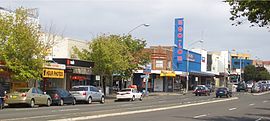Caringbah
|
Caringbah Sydney, New South Wales |
|||||||||||||
|---|---|---|---|---|---|---|---|---|---|---|---|---|---|

The Kingsway, Caringbah
|
|||||||||||||
| Population | 10,955 (2011 census) | ||||||||||||
| Postcode(s) | 2229 | ||||||||||||
| Location | 24 km (15 mi) south of Sydney CBD | ||||||||||||
| LGA(s) | Sutherland Shire | ||||||||||||
| State electorate(s) | |||||||||||||
| Federal Division(s) | Cook | ||||||||||||
|
|||||||||||||
Caringbah is a suburb, in southern Sydney, in the state of New South Wales, Australia. Caringbah is 24 kilometres (15 mi) south of the Sydney central business district in the local government area of Sutherland Shire.
Caringbah once stretched from Woolooware Bay on the Georges River to Yowie Bay and Burraneer Bay on the Port Hacking estuary. A number of Caringbah localities have been declared as separate suburbs but still share the postcode 2229. These suburbs are to the north, Taren Point on the Georges River and to the south, Port Hacking, Lilli Pilli, Dolans Bay and Caringbah South on the Port Hacking River.
Caringbah is an Aboriginal word for a pademelon wallaby. The suburb was originally called Highfield, but it is unclear whether this was a position description or whether it was named after an early resident. Caringbah was used from 1911, after the steam trams began operating between Cronulla and Sutherland.
Thomas Holt (1811–88) owned most of the land that stretched from Sutherland to Cronulla in the 1860s. Most of the area around Miranda and Caringbah was used for market gardening from the 1880s. Caringbah was still used for orchards and farming until after World War II. The railway line to Cronulla opened in 1939.
...
Wikipedia
